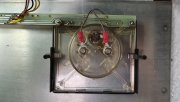Carl182
New Around These Parts
- Joined
- Aug 30, 2021
- Messages
- 22
Placeholder post:
PROBLEMS
OK then, back to the only PROBLEM "Jesse" has. Every help is greatly appreciated!
When the power switch is turned OFF, the Channel A (Left) VU Meter:
- Goes back and stands still at -20 (OFF) position;
- After 10 seconds (amp is OFF remember), pegs VERY rapidly to -1 position;
- From there, takes 12 seconds to slowly go back at -20 (OFF) position.
Some considerations:
- Channel B (Right) VU Meter is OK;
- Channel A VU Meter is responsive when ON, BUT is slightly "behind" Channel B by 0,5 units or so;
- Voltage check on bias and speaker binding posts: it is absolutely equal and steady when comparing L and R;
- This was the only meter which pegged violently at turn-on BEFORE WOPLing/restoring the unit. This PL400 had the common problem of frying speakers via rail voltage, the reason why it was abandoned by previous owner;
- Below a closeup of the meter type from Honeywell. As per WO instructions and documentation, it is NOT the one type I could calibrate (if I understood right).
Some questions:
1) Is the thing gone for good? I really san't see how to operate here...
2) As per pics above, this is the meter extremely close to the new power caps, which are way larger than the originals. Electromagnetism? Aliens?
3) Would the White Oak LED Board somehow solve this?
Thanks in andvance for any help or considerations!
Carl

The Meter BEFORE WOPLing/relamping.

The meter AFTER WOPLing/relamping (switched it from B to A).
Last edited:
